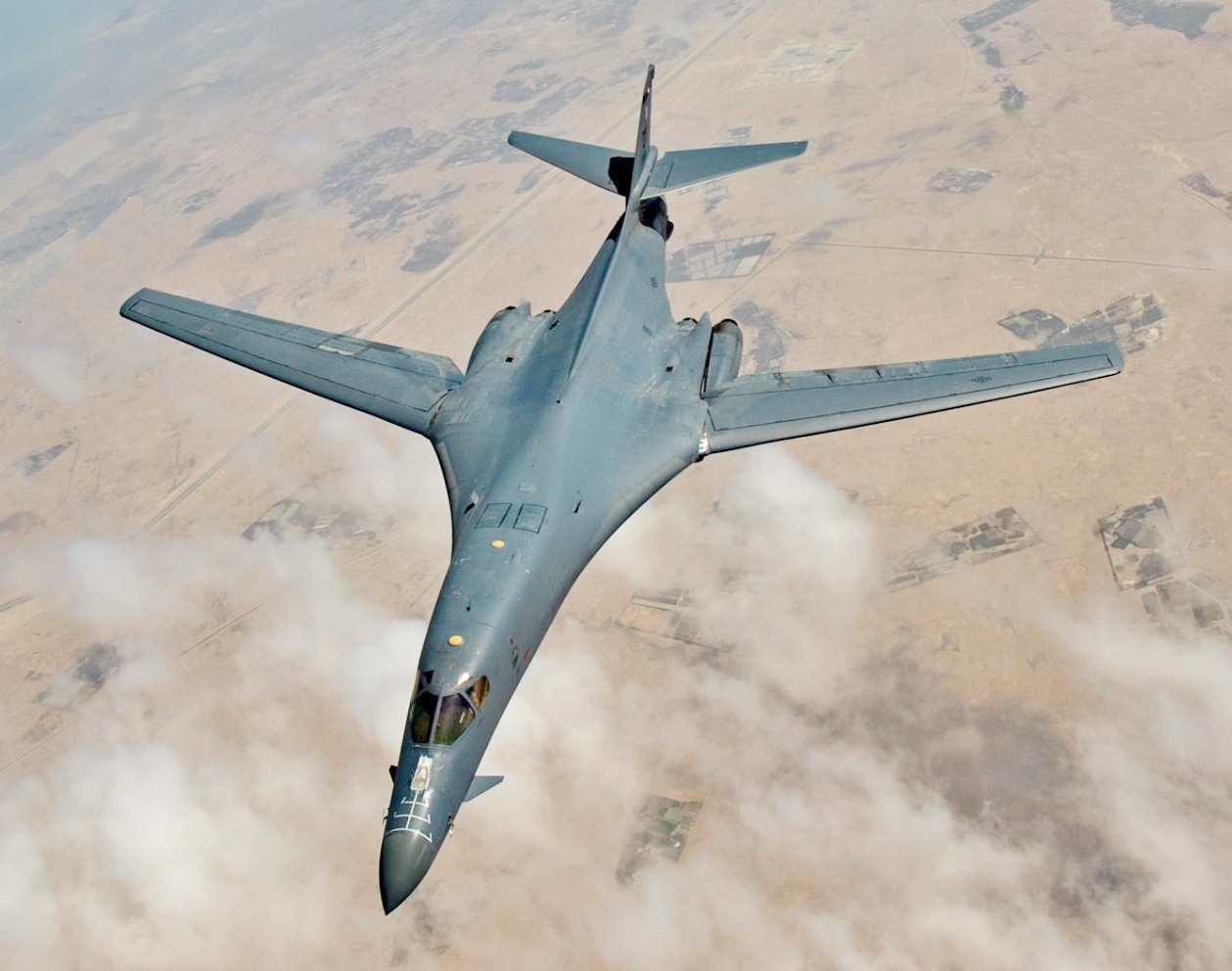|
B-36
The Convair B-36 "Peacemaker" is a strategic bomber built by Convair and operated by the United States Air Force (USAF) from 1949 to 1959. The B-36 is the largest mass-produced piston-engined aircraft ever built, although it was exceeded in span and weight by the one-off Hughes H-4 Hercules. It has the longest wingspan of any combat aircraft. The B-36 was capable of intercontinental flight without refueling. Entering service in 1948, the B-36 was the primary nuclear weapons delivery vehicle of Strategic Air Command (SAC) until it was replaced by the jet-powered Boeing B-52 Stratofortress beginning in 1955. All but four aircraft have been scrapped. Development The design of the B-36 can be traced to early 1941, prior to the entry of the United States into World War II. At the time, Britain was at risk of falling to the Nazi "Blitz" attacks, making strategic bombing attacks by the United States Army Air Corps (USAAC) against Germany impossible with the aircraft available.. The ... [...More Info...] [...Related Items...] OR: [Wikipedia] [Google] [Baidu] |
Convair X-6
The Convair X-6 was an experimental aircraft project to develop and evaluate a nuclear-powered jet aircraft. Experiments were carried out on a testbed aircraft named Convair NB-36H, based on the B-36 bomber. The program was canceled before the actual X-6 and its nuclear reactor engines were completed. The X-6 was part of a larger series of programs that ran from 1946 through 1961, and cost 7 billion USD. The basic idea was that nuclear-powered strategic bombers would be able to stay airborne for weeks at a time, as their range would not be limited by liquid jet fuel. Development and design In May 1946, the Nuclear Energy for the Propulsion of Aircraft (NEPA) project was started by the United States Army Air Forces. Studies under this program were done until May 1951 when NEPA was replaced by the Aircraft Nuclear Propulsion (ANP) program. The ANP program included plans for Convair to modify two B-36s under the MX-1589 project. One of the B-36s was used to study shielding r ... [...More Info...] [...Related Items...] OR: [Wikipedia] [Google] [Baidu] |
Convair NB-36H
The Convair NB-36H was an experimental aircraft that carried a nuclear reactor to test its protective radiation shielding for the crew, but did not use it to power the aircraft. Nicknamed "The Crusader", it was created for the Aircraft Nuclear Propulsion program (ANP for short), to show the feasibility of a nuclear-powered bomber. Its development ended with the cancellation of the ANP program. Design and development The Aircraft Nuclear Propulsion (ANP) program, and the preceding Nuclear Energy for the Propulsion of Aircraft (NEPA) project, worked to develop a nuclear propulsion system for aircraft. The United States Army Air Forces initiated Project NEPA on May 28, 1946. After funding of $10 million in 1947, NEPA operated until May 1951, when the project was transferred to the joint Atomic Energy Commission (AEC)/USAF ANP. The USAF pursued two different systems for nuclear-powered jet engines, the Direct Air Cycle concept, which was developed by General Electric, and Indirect ... [...More Info...] [...Related Items...] OR: [Wikipedia] [Google] [Baidu] |
Convair YB-60
The Convair YB-60 was a prototype heavy bomber built by Convair for the United States Air Force in the early 1950s. It was a purely jet-powered development of Convair's earlier mixed-power B-36 Peacemaker. Design and development On 25 August 1950, Convair issued a formal proposal for a swept-winged version of the B-36 with all-jet propulsion. The Air Force was sufficiently interested that on 15 March 1951, it authorized Convair to convert two B-36Fs (49-2676 and 49-2684) as the B-36G. Since the aircraft was so radically different from the existing B-36, the designation was soon changed to YB-60. The YB-60 had 72% parts commonality with its piston-engined predecessor. The fuselages of the two aircraft were largely identical although the radar and bombing systems were located in a removable nose section as a result of the poor reliability of the B-36 installation. For initial flight testing a more streamlined nose with an instrumented boom was fitted; a wedge-shaped insert was a ... [...More Info...] [...Related Items...] OR: [Wikipedia] [Google] [Baidu] |
Convair XC-99
The Convair XC-99, AF Ser. No. ''43-52436'', is a prototype heavy cargo aircraft built by Convair for the United States Air Force. It was the largest piston-engined land-based transport aircraft ever built, and was developed from the Convair B-36 Peacemaker bomber, sharing the wings and some other structures with it. The first flight was on 24 November 1947 in San Diego, California, and after testing it was delivered to the Air Force on 26 May 1949.Jacobsen & Wagner 1980, p. 41. The Convair Model 37 was a planned civil passenger variant based on the XC-99 but was not built. Design and development Design capacity of the XC-99 was of cargo or 400 fully equipped soldiers on its double cargo decks. A cargo lift was installed for easier loading. The engines face rearward in a pusher configuration. Planned civil passenger variant The Convair Model 37 was a large civil passenger design derived from the XC-99 but was never built. The Model 37 was to be of similar proportions to the X ... [...More Info...] [...Related Items...] OR: [Wikipedia] [Google] [Baidu] |
Convair
Convair, previously Consolidated Vultee Aircraft Corporation, was an American aircraft-manufacturing company that later expanded into rockets and spacecraft. The company was formed in 1943 by the merger of Consolidated Aircraft and Vultee Aircraft. In 1953, it was purchased by General Dynamics, and operated as their Convair Division for most of its corporate history. Convair is best known for its military aircraft; it produced aircraft such as the Convair B-36 Peacemaker and Convair B-58 Hustler strategic bombers, and the Convair F-102 Delta Dagger and Convair F-106 Delta Dart interceptors. It also manufactured the first Atlas rockets, including the rockets that were used for the crewed orbital flights of Project Mercury. The company's subsequent Atlas-Centaur design continued this success and derivatives of the design remain in use as of 2025. The company also entered the jet airliner business with its Convair 880 and Convair 990 designs. These were smaller than conte ... [...More Info...] [...Related Items...] OR: [Wikipedia] [Google] [Baidu] |
Amerikabomber
The ''Amerikabomber'' () project was an initiative of the German Ministry of Aviation (''Reichsluftfahrtministerium'') to obtain a long-range strategic bomber for the ''Luftwaffe'' that would be capable of striking the United States (specifically New York City) from Germany, a round-trip distance of about . The concept was raised as early as 1938, but advanced plans for such a long-range strategic bomber design were not presented to ''Reichsmarschall'' Hermann Göring until early 1942. Various proposals were put forward, but these plans were all eventually abandoned as they were too expensive, too reliant on rapidly diminishing materiel and production capacity, and/or technically infeasible. Background According to Albert Speer's book, '' Spandau: The Secret Diaries'', Adolf Hitler was fascinated with the idea of New York City in flames. In 1937, Willy Messerschmitt hoped to win a lucrative contract by showing Hitler a prototype of the Messerschmitt Me 264 that was being design ... [...More Info...] [...Related Items...] OR: [Wikipedia] [Google] [Baidu] |
Strategic Air Command
Strategic Air Command (SAC) was a United States Department of Defense Specified Command and a United States Air Force (USAF) Major Command responsible for command and control of the strategic bomber and intercontinental ballistic missile components of the United States military's strategic nuclear weapon, strategic nuclear forces from 1946 to 1992. SAC was also responsible for strategic reconnaissance aircraft; airborne command posts; and most of the USAF's aerial refueling aircraft. SAC primarily consisted of the Second Air Force (2AF), Eighth Air Force (8AF) and the Fifteenth Air Force (15AF), while SAC headquarters (HQ SAC) included Directorates for Operations & Plans, Intelligence, Command & Control, Maintenance, Training, Communications, and Personnel. At a lower echelon, SAC headquarters divisions included Aircraft Engineering, Missile Concept, and Strategic Communications. In 1992, as part of an overall post-Cold War reorganization of the U.S. Air Force, SAC was disesta ... [...More Info...] [...Related Items...] OR: [Wikipedia] [Google] [Baidu] |
Boeing B-52 Stratofortress
The Boeing B-52 Stratofortress is an American long-range, subsonic aircraft, subsonic, jet-powered strategic bomber. The B-52 was designed and built by Boeing, which has continued to provide support and upgrades. It has been operated by the United States Air Force (USAF) since 1955 and was flown by NASA from 1959 to 2007. The bomber can carry up to of weapons and has a typical Range (aeronautics), combat range of around without aerial refueling. After Boeing won the initial contract in June 1946, the aircraft's design evolved from a straight wing, straight-wing aircraft powered by six turboprop engines to the final prototype YB-52 with eight turbojet engines and swept wings. The B-52 took its maiden flight in April 1952. Built to carry nuclear weapons for Cold War Nuclear strategy, deterrence missions, the B-52 Stratofortress replaced the Convair B-36 Peacemaker. The bombers flew under the Strategic Air Command (SAC) until it was disestablished in 1992 and its aircraft abso ... [...More Info...] [...Related Items...] OR: [Wikipedia] [Google] [Baidu] |
United States Army Air Corps
The United States Army Air Corps (USAAC) was the aerial warfare service component of the United States Army between 1926 and 1941. After World War I, as early aviation became an increasingly important part of modern warfare, a philosophical rift developed between more traditional ground-based army personnel and those who felt that aircraft were being underutilized and that air operations were being stifled for political reasons unrelated to their effectiveness. The USAAC was renamed from the earlier United States Army Air Service on 2 July 1926, and was part of the larger United States Army. The Air Corps became the United States Army Air Forces (USAAF) on 20 June 1941, giving it greater autonomy from the Army's middle-level command structure. During World War II, although not an administrative echelon, the Air Corps (AC) remained as one of the combat arms of the Army until 1947, when it was legally abolished by legislation establishing the United States Department of the Air Fo ... [...More Info...] [...Related Items...] OR: [Wikipedia] [Google] [Baidu] |
Strategic Bomber
A strategic bomber is a medium- to long-range Penetrator (aircraft), penetration bomber aircraft designed to drop large amounts of air-to-ground weaponry onto a distant target for the purposes of debilitating the enemy's capacity to wage war. Unlike tactical bombing, tactical bombers, Penetrator (aircraft), penetrators, fighter-bombers, and attack aircraft, which are used in air interdiction operations to attack enemy combatants and military equipment, strategic bombers are designed to fly into enemy territory to destroy strategic targets (e.g., infrastructure, logistics, Military base, military installations, factories, etc.). In addition to strategic bombing, strategic bombers can be used for tactical bombing, tactical missions. There are currently only three countries that operate strategic bombers: the United States, Russia and China. The modern strategic bomber role appeared after Strategic bombing during World War II, strategic bombing was widely employed, and Atomic bombing ... [...More Info...] [...Related Items...] OR: [Wikipedia] [Google] [Baidu] |
Nuclear Weapons Delivery
Nuclear weapons delivery is the technology and systems used to place a nuclear weapon at the position of detonation, on or near its target. All nine nuclear states have developed some form of medium- to long-range delivery system for their nuclear weapons. Alongside improvement of weapons, their development and deployment played a key role in the nuclear arms race. Strategic nuclear weapons are intended primarily as part of a doctrine of deterrence by threatening large targets, such as cities or military installations. These are generally delivered by some combination of land-based intercontinental ballistic missiles, sea-based submarine-launched ballistic missiles, and air-based strategic bombers carrying gravity bombs or cruise missiles. The possession of all three is known as a nuclear triad. Tactical nuclear weapons are intended for battlefield usage and/or destroying specific military, communications, or infrastructure targets, and generally have lower yields ... [...More Info...] [...Related Items...] OR: [Wikipedia] [Google] [Baidu] |








